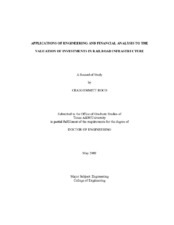| dc.contributor.advisor | Damnjanovic, Ivan | |
| dc.creator | Roco, Craig E. | |
| dc.date.accessioned | 2010-01-16T00:07:50Z | |
| dc.date.available | 2010-01-16T00:07:50Z | |
| dc.date.created | 2009-05 | |
| dc.date.issued | 2010-01-16 | |
| dc.identifier.uri | https://hdl.handle.net/1969.1/ETD-TAMU-2009-05-559 | |
| dc.description.abstract | This record of study presents the findings of industry research projects performed during
a one-year doctoral internship with the Austin Rail Group of HNTB Corporation. Four
main internship objectives were established that address infrastructure problems related
to the railroad industry and required the integration of engineering and financial analysis
to develop effective project evaluation tools. Completion of the objectives resulted in:
1. Transformation of the Federal Railroad Administration methodology
currently used to perform highway-railroad grade crossing analyses to a
system of equations that can easily be used to evaluate regional rail
infrastructure investments. Transportation engineering equations based on
queuing theory were extended to new but equivalent formulations that
accommodate unlimited, discrete train performance data from computer
simulations of rail networks.
2. Application of risk assessment methods and railroad accident statistics to
recommend a cost-effective alternative to legislative proposals to relocate
hazardous materials transported by rail around metropolitan areas. A risk
analysis model was developed to predict the risk of exposure from the release
of a hazardous material following a train derailment so that changes in
exposure achieved by alternative risk mitigation strategies could be observed.
3. A new method of measuring the susceptibility of railroads to financial
distress following the catastrophic loss of a timber railroad bridge. Economic
and finance principles were used to predict financial distress by determining
of the number of revenue periods required to offset economic loss.
4. Demonstration of the use of financial market data in calculating the discount
rate of public railroad companies for engineering analyses that involve
negotiations with the public agencies. Surface Transportation Board rulings
on the determination of a railroad?s cost of equity were applied to a
comparative assessment of costs of capital for Class I railroads. A
hypothetical example was used to demonstrate the interrelationship between
engineering design strategies and their effects on the pricing of compensation
to a railroad for right-of-way acquisition.
These results, in fulfillment of the doctoral internship objectives, have provided HNTB
with economic decision analysis tools and a series of conclusions used to provide
recommendations to the Illinois, Missouri, and Texas Departments of Transportation, the
Texas Legislature, and the railroad industry. | en |
| dc.format.mimetype | application/pdf | |
| dc.language.iso | en_US | |
| dc.subject | railroad
finance
engineering analysis | en |
| dc.title | Applications of Engineering and Financial Analysis to the Valuation of Investments in Railroad Infrastructure | en |
| dc.type | Book | en |
| dc.type | Thesis | en |
| thesis.degree.department | College of Engineering | en |
| thesis.degree.discipline | Engineering | en |
| thesis.degree.grantor | Texas A&M University | en |
| thesis.degree.name | Doctor of Engineering | en |
| thesis.degree.level | Doctoral | en |
| dc.contributor.committeeMember | Luca, Quadrifoglio | |
| dc.contributor.committeeMember | Lomax, Tim | |
| dc.contributor.committeeMember | Woods, Calvin | |
| dc.type.genre | Electronic Dissertation | en |


